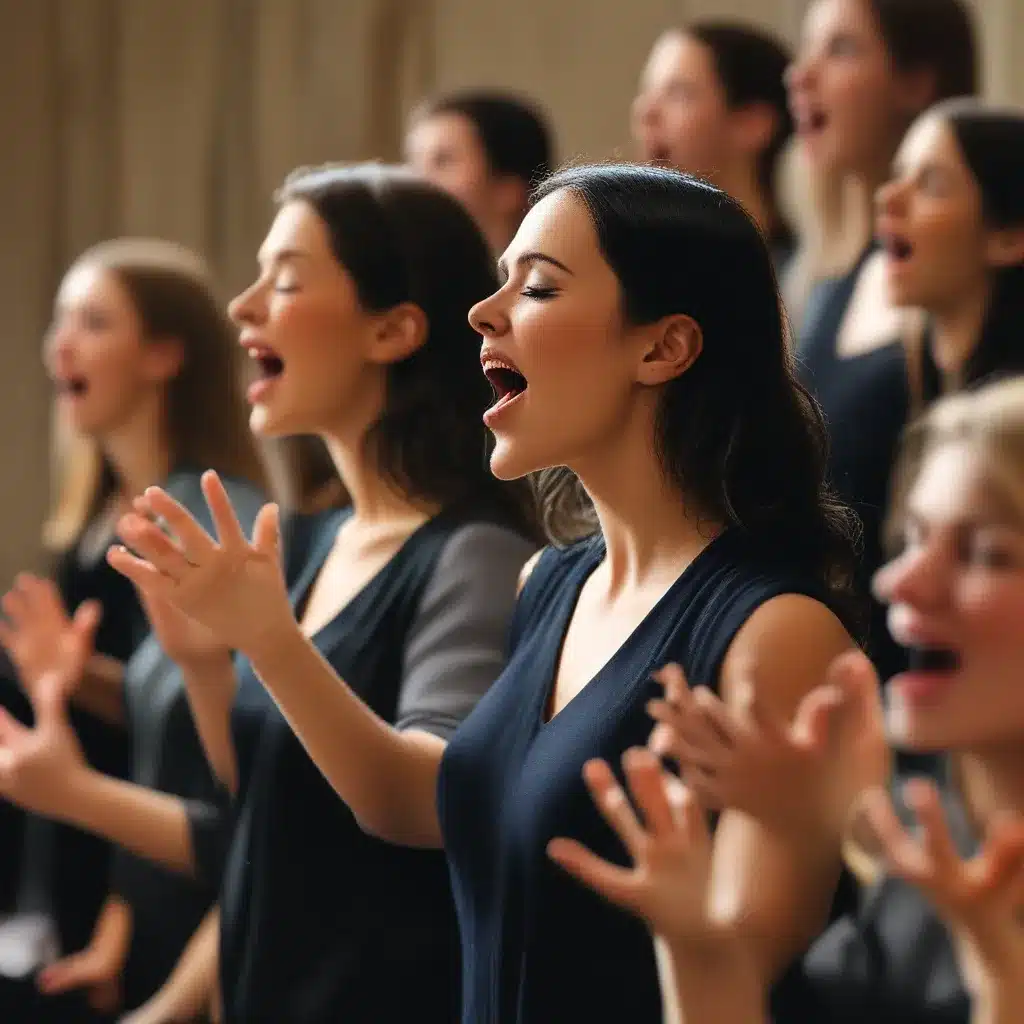
Harmonizing Like a Heavenly Choir
As I stepped into the cozy confines of the Turf Club on that chilly January night, I was immediately swept up in the captivating energy of the local music scene. The first band, Services, took the stage with lead singer Sylvia Jennings delivering a performance charged with dramatic flair that evoked the alternative sound of the 1990s. It was a thrilling introduction to the evening’s festivities.
But what really struck me, beyond the sheer talent of the individual artists, was the way the various ensembles blended their voices and instruments to create a cohesive, harmonious sound. It was as if they had honed the art of vocal dynamics to perfection, seamlessly weaving their unique contributions into a rich musical tapestry.
This got me thinking about the importance of ensemble singing and the techniques required to achieve that elusive harmony. As a passionate advocate for musical theater education, I knew I had to dig deeper and share my insights with the community at the Musical Theater Center.
The Power of Blended Voices
Vocal dynamics, the art of controlling volume, pitch, and timbre, are the backbone of ensemble singing. When done well, it can transform a group of talented individuals into a divine chorus, captivating the audience and elevating the performance to new heights.
Take Extraterrestrials, for example. Clad in their matching red jumpsuits, the five-piece Minneapolis band evoked the energy and nostalgia of 1980s new wave and classic rock. But it was their seamless blending of voices that truly made their performance so enchanting. As they effortlessly traded lead vocal duties and harmonized in perfect unison, the audience was transported to another realm.
Similarly, FènixDion’s electrifying set showcased a dynamic combination of soulful vocals, funky grooves, and a diverse array of instrumentation. Frontman Keston Wright’s powerful delivery was perfectly complemented by the backing vocals, creating a rich, immersive musical experience that would have made the late, great Prince proud.
The Art of Vocal Blending
Achieving this level of ensemble harmony is no easy feat. It requires a deep understanding of vocal dynamics and a keen ability to listen and adapt to one’s fellow performers. Let’s delve into the key elements that make up this captivating art form.
Pitch Matching
The foundation of any great ensemble is the ability to match pitch. This means ensuring that each singer is hitting the same notes at the same time, creating a cohesive and in-tune sound. It’s a skill that requires meticulous practice and a keen musical ear. As Ken Tamplin, a professional vocal coach, explains, “Matching pitch is crucial for blending voices. It’s the difference between sounding like a choir and sounding like a cacophony of individual singers.”
Vowel Unification
Another critical element of vocal blending is the unification of vowel sounds. When singers in an ensemble maintain consistent vowel shapes, the result is a seamless, unified timbre that resonates with the audience. Imagine a choir singing “ah” in perfect unison – the collective sound is simply mesmerizing. By aligning their mouth shapes and vocal placement, the singers create a cohesive, harmonious blend.
Volume Regulation
Balancing volume is also essential for effective ensemble singing. Each vocalist must be cognizant of their individual volume and adjust it to complement the group. This allows the ensemble to achieve a dynamic range, with some parts singing softly to highlight others, and then swelling together for a powerful climax. As these vocal training videos demonstrate, mastering volume control is a crucial skill for any singer looking to excel in an ensemble setting.
Breath Support
Proper breath support is the foundation upon which all other vocal techniques are built. In an ensemble, it’s critical that each singer is coordinating their breathing to ensure a seamless, sustained sound. By taking deep, controlled breaths and maintaining excellent posture, the vocalists can create a cohesive, resonant blend that captivates the audience.
Listening and Adapting
Lastly, the ability to listen and adapt is perhaps the most important aspect of ensemble singing. Each performer must be acutely aware of their fellow singers, constantly adjusting their pitch, volume, and vowel placement to achieve the perfect blend. It’s a delicate dance of give and take, where the individual ego is sacrificed for the greater good of the group.
Putting it All Together
As I reflect on the incredible performances I witnessed that night at the Turf Club, I’m reminded of the power of ensemble singing when these elements are executed with mastery. The way Services, Lighter Co, Extraterrestrials, and FènixDion blended their voices and instruments was nothing short of mesmerizing.
It’s a testament to the countless hours of practice, the deep musical understanding, and the sheer dedication of these talented artists. They’ve honed their craft to the point where they can intuitively sense the needs of the group and adjust their individual contributions accordingly.
And that’s the true beauty of ensemble singing – the way it transcends the individual and creates something greater than the sum of its parts. When a group of vocalists can seamlessly blend their voices, they don’t just perform a song; they weave a musical tapestry that envelops the audience and transports them to another plane of existence.
As the Musical Theater Center continues to nurture the next generation of musical theater performers, I can’t help but feel inspired by the potential for these young artists to master the art of vocal dynamics and ensemble singing. With the right training, guidance, and dedication, they too can captivate audiences and elevate the art form to new heights.
So let’s raise a metaphorical glass to the power of blended voices, the magic of seamless harmony, and the pursuit of musical excellence. The future of ensemble singing is bright, and I can’t wait to see what these talented performers have in store.

